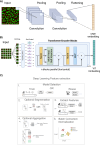This is a preprint.
Progress and new challenges in image-based profiling
- PMID: 40799808
- PMCID: PMC12340881
Progress and new challenges in image-based profiling
Abstract
For over two decades, image-based profiling has revolutionized cellular phenotype analysis. Image-based profiling processes rich, high-throughput, microscopy data into unbiased measurements that reveal phenotypic patterns powerful for drug discovery, functional genomics, and cell state classification. Here, we review the evolving computational landscape of image-based profiling, detailing current procedures, discussing limitations, and highlighting future development directions. Deep learning has fundamentally reshaped image-based profiling, improving feature extraction, scalability, and multimodal data integration. Methodological advancements such as single-cell analysis and batch effect correction, drawing inspiration from single-cell transcriptomics, have enhanced analytical precision. The growth of open-source software ecosystems and the development of community-driven standards have further democratized access to image-based profiling, fostering reproducibility and collaboration across research groups. Despite these advancements, the field still faces significant challenges requiring innovative solutions. By focusing on the technical evolution of image-based profiling rather than the wide-ranging biological applications, our aim with this review is to provide researchers with a roadmap for navigating the progress and new challenges in this rapidly advancing domain.
Conflict of interest statement
Conflict of Interest NOC is co-founder, shareholder and management consultant for PhenoTherapeutics Ltd. S.S. and A.E.C. serve as scientific advisors for companies that use image-based profiling and Cell Painting (A.E.C: Recursion, SyzOnc, Quiver Bioscience, S.S.: Waypoint Bio, Dewpoint Therapeutics, Deepcell) and receive honoraria for occasional scientific visits to pharmaceutical and biotechnology companies. All other authors declare that they have no conflict of interest.
Figures



References
-
- Aggarwal CC, Hinneburg A & Keim DA (2001) On the surprising behavior of distance metrics in high dimensional space. In Database Theory — ICDT 2001 pp 420–434. Berlin, Heidelberg: Springer Berlin Heidelberg
-
- Krizhevsky Alex et al. (2017) ImageNet classification with deep convolutional neural networks. Communications of the ACM
-
- Alieva M, Wezenaar AKL, Wehrens EJ & Rios AC (2023) Bridging live-cell imaging and next-generation cancer treatment. Nature Reviews Cancer 23: 731–745 - PubMed
Publication types
Grants and funding
LinkOut - more resources
Full Text Sources
